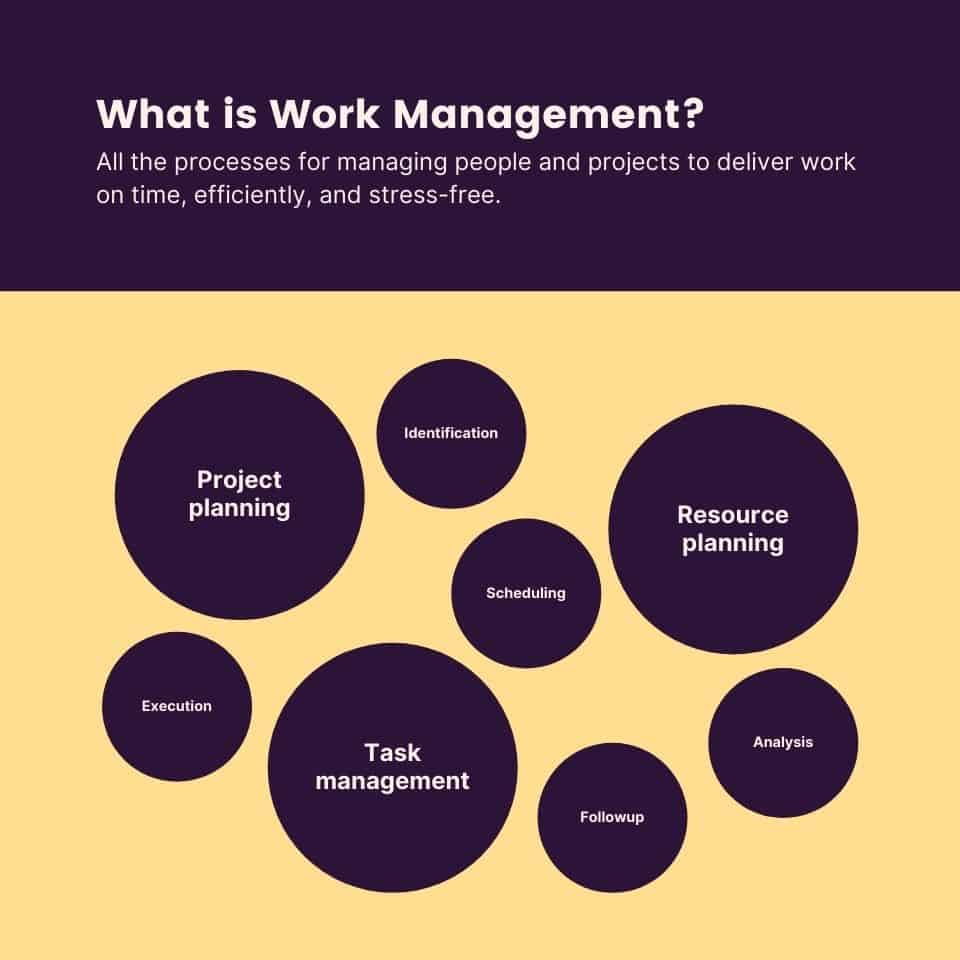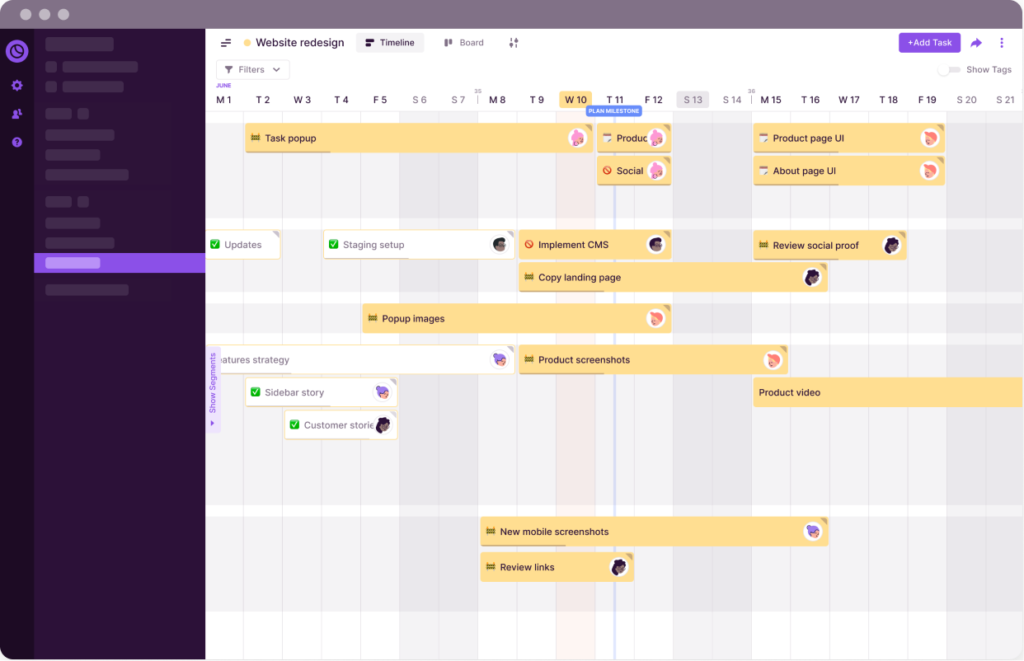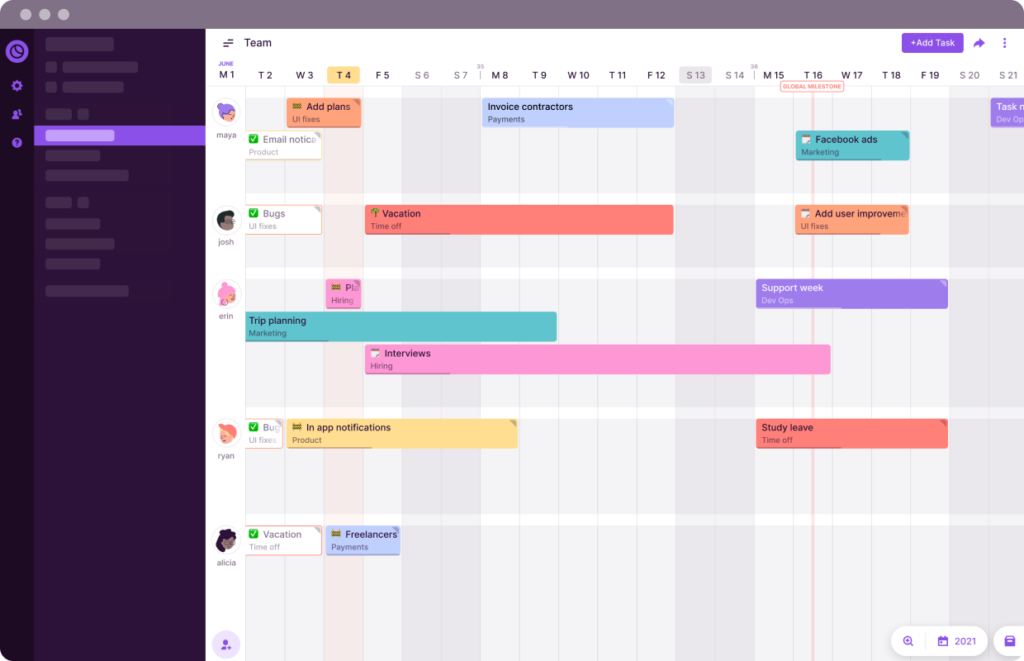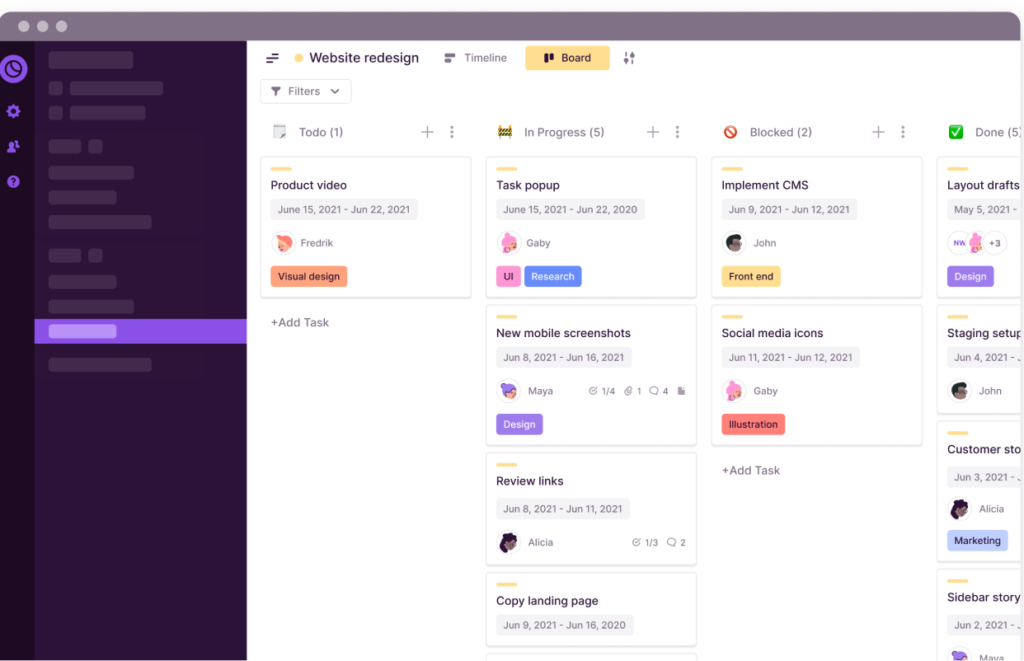The way many of us work has changed over the past two years, one of the most significant evolutions being the mainstream adoption of remote work — which is definitely here to stay.
Often considered a last resort option due to the assumption that unsupervised employees wouldn’t deliver as much as they should, many studies conducted in the past 18 months show that remote employees get more done. Of course, one might argue that this is a great thing for organizations as they get to produce more with the same amount of resources.
But there’s a significant caveat.
On top of working remotely, project-based teams (such as creative, consultancy, or implementation teams) follow a flexible schedule, depending on how much work is coming their way. While it gives employees more chances to work at their own pace, it also leaves room for challenges such as:
- Facing unstructured asynchronous communication.
- Missing clarity and the bigger picture.
- Dealing with unbalanced workloads.
- Suffering from potential distractions at home.
- Increased stress levels.
… and, therefore, difficulties to meet deadlines without doing long(er) hours.
The result is here for all of us to see:
- 4 in 10 employees say they have experienced burnout during the pandemic. (FlexJobs)
- 7 in 10 believe that burnout rates have worsened during the pandemic (Source: Indeed).
- 4 in 10 employees say they now work longer hours than before the pandemic (Source: FlexJobs).
- 6 in 10 employees say they find it more challenging to unplug from work (Source: Indeed).
This is dangerous, not only for employees’ mental health but also for organizations. Additionally, Gallup reveals that burned-out employees are 63 % more likely to take sick days and 2.6x more likely to look for another job.
One simple solution to this complex problem is better Work Management.
In this guide addressed to small teams essentially delivering project-based work, you’ll learn everything you need to know about work management, from what it means to who it is for, how to approach it, and how to deploy it.
Here’s what we’ll cover:
- What is work management?
- Why are work management processes so important?
- Does your business need work management?
- How to select the right work management solution for your team?
Definition: What is work management?
Work management refers to all activities and processes leading to structuring and coordinating the work for the employees of an organization within the scope of projects (and/or to an organizational level).
In other words, adopting the right work management processes and tools makes it possible to support the performance of a team (or an organization) by adding structure, visibility and flexibility, and by keeping everyone’s stress levels in check.
Interestingly enough, project management is often confused with work management; this ends now.
Work management vs. project management
Work management and project management are related but are also often mistakenly confused for one another. While gravitating around the same space, they are different by nature.
- Project management only focuses on documentation, tracking, communication, and project deliverables. You can guess from the naming that the scope of project management is … projects. It is a repeating process involving pre-defined deliverables and is limited in time (from ideation to completion).
- Work management, on the other hand, refers to ongoing and iterative processes that include, among other things, project management.
Are you still finding it challenging to picture what work management is all about? Let’s take a minute to define its full scope.
What’s the full scope of a work management ecosystem for small teams?
Work management is an overarching term that includes a variety of disciplines, from project planning to resource planning, task management, invoicing, or work analysis.

Large organizations may need to consider implementing all aspects of work management for all teams to function effectively and efficiently – and because they have the people and resources to do so. However, for obvious reasons, smaller organizations and teams often lack the time (people) and resources (money, skills, and technology) to implement all work management best practices.
Fortunately, you don’t have to go all-in.
Focus on what keeps you and your team up at night:
- Are we able to deliver our next projects on time?
- Could we take up more work?
- How do I keep my team happy?
- Is my team working at capacity?
- Do I need to hire more people?
While we can consider most work management processes as nice-to-haves for small teams delivering projects, three are essential to answer the questions raised above: project planning, resourcing planning, and task management.

Project planning
Lacking a plan often means having no direction and getting no result. From picturing who is available, when, project planning refers to all elements necessary to plan the delivery of projects in the right conditions, ahead of time.
Thorough project planning helps managers to clearly define the scope of their current and future projects by providing answers to the following questions:
- What are we trying to achieve?
- When is the project due?
- What do my clients need?
- What do we need to deliver the project on time?
- What are the dependencies and potential roadblocks?
As for your team, having a clearly defined plan means stressing less about the tasks ahead.
Resource planning (or team planning)
The central component of work management, resource (or team) planning refers to planning people’s time and distributing the next tasks and projects based on who’s available, when. It allows busy teams to deliver work on time without overworking themselves.
Finding talent is one thing. Retaining and keeping them motivated, however, is easier said than done, especially now that the employment time is shortening.
For instance, the U.S. Bureau of Labor Statistics reveals that workers aged 25 to 34 only stay, on average, 2.8 years in their organization (vs. 9.9 years for employees aged 55 to 64). This makes resource planning a priority to ensure that your team is happy and enjoys their work.
Task management
Tasks are a fundamental measurement unit and are one of the most concrete aspects of work management. A structured task management process is the most efficient way to know what your team is up to at any given time, who they work with, and if they need help.
Don’t confuse task management for micro-management.
Micro-management is a technique of the past. It destroys trust, reduces autonomy, stresses both managers and their employees, and can increase turnover rates.
On the other hand, task management purposely supports collaborative work, encourages transparency, and increases trust levels between managers and employees.
Our advice? Steer away from micro-management. Keep things simple, trust your team to get the job done, and offer help when needed.
Why are work management processes so important?
The whole idea of work management is to provide order to your work in a way that suits you, your team, and/or your entire organization best.
Let’s put it that way; when well implemented, work management processes should make work feel a lot less like work.
Now, the beauty (and challenge) of work management is that there’s no one-size-fits-all model that you can copy/paste and follow. The benefits, however, are universal, and we have identified four reasons why adopting better work management processes matters for you and your team.
- Provide a structure to your work
- Plan and deliver work, stress-free
- Enable collaborative work
- Protect your team and lower stress levels
Provide a structure to your work
When dealing with big projects or a ton of smaller projects for various customers, not having a structure will ultimately spread your team too thin. Delivering projects requires order.
Why structure matters
If you want to keep your customers happy, you need structure. It is the foundation of everything you do.
Structured work is about defining clear tasks to be complete in a given order before a set deadline. Structured work should be well-documented, assigned ahead of time, scheduled, and delivered on time. Consequently, it lets everyone know what’s expected of them, who depends on their tasks, and when to deliver them. It improves:
- Efficiency (especially in remote environments).
- Communication (by creating a structure for asynchronous communication).
- Anticipation (and prevention of potential roadblocks).
- Accountability (especially when a project involves many people and moving pieces).
Centralize work and communication
Communication can make or break a project.
A standard work management best practice is to centralize information to reduce friction, support communication, and prevent siloed work.
Centralizing information is also one of the best ways to eliminate unnecessary meetings with your team or customers. If you make it easy for everyone to follow up and onboard themselves on a project, whatever it may be, you will save a lot of time and eliminate lengthy catchup meetings.
Plan and deliver your work, stress-free
You cannot improvise success.
While it might not look like it from the outside, successful projects are always carefully planned, from ideation to delivery. Sure, luck can play a part in turning good projects into successful ones, but success never happens without careful planning.
Plan projects well ahead
Planning ahead will not only help you and your team deliver quality work on time, but it will also give you a chance to communicate clearly with customers and manage expectations.
Our customers tell us that project planning is the best way for project managers to leave less room for the unexpected. Or, at the very least, when the unexpected does happen, it gives them room to plan alternatives for if and when things don’t go as planned.
“We have a weekly planning meeting where we re-evaluate the timelines, reschedule if needed, and decide whether or not there are things that need to be outsourced.”
—Pärtel Vurma, Managing Partner & Design Lead, Velvet
Read how Velvet streamlined its planning processes.
Eat all what you can with proper resource planning
Since working from home is now common for a lot of teams across the world, it’s been challenging for project leads and managers to set boundaries to prevent their colleagues from overworking themselves and, in some situations, burn themselves out.
Done right, resource planning gives managers a clear view of everyone’s workload and makes it possible to avoid situations where an employee or an entire team has to complete a lot of work in a record (read: unachievable) amount of time.
At the same time, proper resource planning gives employees peace of mind, knowing that they won’t have to push their limits.
“Toggl Plan allows the designers to go back and look at what they’ve worked on and also see how long something took. So now I know how much time to allocate for any new brief that’s similar.”
—Chanel Kennedy, Studio Manager, Boiler Room
Read Boiler Room’s resource management story.
In application, it is quite common for project-based teams to be swamped in work. And it shouldn’t be that way.
Following simple resource planning processes — such as planning work according to availability, taking up new projects based on actual team capacity, or balancing workloads equally between team members — creates boundaries; it protects people from situations when they’d have to overwork themselves to complete work on time.
Rigorously plan flexible projects
The best plan As have plan Bs and Cs.
As the infamous Murphy’s Law puts it: “If anything can go wrong, it will”.
Complex projects often come with a ton of moving pieces. And moving pieces come with dependencies. This means that if something is stuck or delayed — whatever the reason —, the entire project might suffer if you don’t have a plan B.
In short, planning ahead means being able to anticipate alternative routes if and when something goes wrong.
Enable collaborative work
What makes teamwork possible? Clear and transparent communication, flexibility, and availability.
Now, teamwork is praised by most, but often poorly executed. And more often than not, teamwork fails because one of the above characteristics is missing.
- You can communicate and be flexible, but teamwork won’t happen if you, or other team members, aren’t available.
- You could be flexible and available, but you will struggle to deliver anything good as a team without clear and transparent communication.
- And finally, communication and availability won’t be enough if the members of a team aren’t able to adapt the way they work to fit the team and/or their customers. Soon enough, you’d find yourself juggling with time-consuming tools and processes no one wants to use and follow.
Here again, our three central work management processes (project planning, resource planning, and task management) are the foundation of any successful teamwork.
- They provide clarity and make it easy to communicate.
- Planning ahead is the best way to ensure anyone’s availability.
Planning ahead gives a 360-degree view of what’s happening and what’s coming your way, thus making it possible to anticipate roadblocks, identify dependencies well in advance, and, therefore, leaving room for adaptability and flexibility.
Keep people happy and lower stress level
4-day week, nap rooms, unlimited holiday policy, etc. Before the COVID-19 pandemic, employee wellbeing was already gaining ground in a lot of organizations.
As the competition for talent rages on (and only gets fiercer), organizations need to find ways to attract, hire and keep the best talent on the market. They also need to ensure that their people are happy and in the best condition to deliver their best work.
Then, COVID-19 happened.
And with it, an increase of stress levels — for a variety of reasons (isolation, working longer hours, imposter syndrome, loud work environment, health, and economic crisis, etc.).
Of course, organizations can’t be fixing everything. However, managers can have a positive effect on their teammates by setting those boundaries we mentioned just above. By providing a structured work environment to their employees and teams, managers can support their employees’ mental health and keep stress levels at a minimum.
What’s more, providing structure to employees makes it easier for them to understand what’s expected of them, increases trust levels in an organization, and eliminates the need to micromanage.
“The weekly digest email gives (my team) a snapshot of what they have to do that week, which we really like, that way, the employees can schedule out their day-to-day.”
—Chanel Kennedy, Studio Manager, Boiler Room
Overall, work management makes room for clarity, agility, and flexibility so that your team can solely focus on delivering quality work – and not on the boring and stressful administrative tasks.
So far we’ve looked at what Work Management is and why it’s important. But is it even compatible with your business?
Does your business need work management?
Long story short, yes.
And if you want a more detailed answer, yes (especially for project-based teams). We at Toggl Plan believe that creative agencies, consultancies, and software implementation teams could really benefit from structured work management processes to empower their employees.
Here’s why:
Work management for Creative Agencies
Creative agencies often need to deliver plethoric projects at a fast pace.
They often lack visibility on who does what and when making it difficult to plan ahead.
Resourcing is also a common problem for most agencies as they always need to know if they can take on new projects without risking overworking the team.
Work management for Consultancies
Just like creative agencies, consultancies too, lack visibility on who does what and when.
Having the ability to plan ahead is vital for them to deliver regular and profitable client projects and prevent employees from burning out because of overwork.
Work management for Implementation teams
Software implementation teams work on tight schedules they have very little control over.
As sales and customer success teams sell and/or upsell new projects, implementation teams often need to chew more than they can take. Having more visibility on team availability helps hundreds of implementation teams to clearly communicate how much work they can take, when, therefore preventing stressful situations where work is rushed.
Great. Now that you know more about work management and why you need to double down on implementing structured processes, it’s time we talk about how to do it.
How to select the right work management solution for your team?
There are a lot of decent free options out there. In fact, the most common (and free) work management option is Google’s Workspace.
- It’s free.
- It’s one-size-fits-all.
- It doesn’t require training.
- You don’t need any specific software or hardware to use it; just an internet connection.
But then again, you get what you pay for. And if it’s free and built as a one-size-fits-all, you can’t expect it to be optimized for your team.
The issue with such tools is that you often need to multiply them to get the desired outcome. Of course, that creates other problems:
- Decentralized information
- More room for errors
- More tools = more potential for security breaches
- Loss of productivity
- Lack of visibility over everything.
“On an Excel sheet, I’m just looking at black and white, and it’s so easy to get confused.”
—Ada Enechi, Producer & Production Manager, BuzzFeed
Read why Buzzfeed ditched spreadsheets to improve work visibility.
Now, if you’re like most people, you’ve probably used Spreadsheets as a home for your work management processes. And many of you reading those lines might actually still use it for that purpose.
If so, we understand. After all, it’s inexpensive, and you can even build decent project timelines with Spreadsheets, but they also quickly turn into a hot mess, right? Your ideal work management toolbox shouldn’t be a hot mess. It should be a clear environment you and your team like to use.
The ideal work management toolbox for your team
Say you purchase the most comprehensive tools on the market. What good would it do if no one would use them? The best tools are evidently the ones you and your team actually use.
Small teams often lack the time (people), skills, or technology to conduct and deliver projects on time. So, why would they have time to deal with complicated software to structure their work?
There’s no need to reinvent the wheel; the simpler, the better. As we’ve mentioned earlier, we believe your work management toolbox should include simple and easy-to-use project planning, resource planning, and task management features.
What makes a good project planning tool?
Your work management toolbox should first and foremost include advanced yet visual project planning capabilities.
Of course, project planning could be done using Spreadsheets or other complex project management solutions. And it would most likely tick some of your boxes.
Your project planning tool should:
- Be highly visual.
- Provide project leads with a bird’s eye view of everything that’s going on regarding ongoing and future projects.
- Make it easy to edit and adjusts plans on the go.
- Give team members a way to visualize what’s coming their way to better organize themselves, deliver work on time, and avoid surprise workloads (and generate stress).
- Be easy to use.
 Project timeline makes it easy to visualize project plans. ” class=”wp-image-27576″/>
Project timeline makes it easy to visualize project plans. ” class=”wp-image-27576″/>We tried other planning tools, but none had the same client-friendly view as Toggl Plan.
—Piers Tincknell, Co-founder at Atomic Smash
What makes a good resource planning tool?
Resourcing is paramount for small teams.
As they work on different projects, small teams tend to juggle with many moving pieces and the smallest changes can have disastrous impacts on your teammates’ ability to deliver all projects on time – let alone the effects on the mental state of your team members.
Your resource planning tool should:
- Let you visualize your team’s availability as well as your teammates’ workload.
- Help you work at capacity and deliver profitable projects.
- Prevent your team from overworking itself.
Here’s an example of how it looks in Toggl Plan:

This type of information makes it possible to always work at capacity and be profitable without overworking your team.
“Now that I use Toggl Plan, I don’t have to calculate the number of available hours for each member of my team. In one second, I can see if the next month is full—or not—or if we have room for more projects.”
—Guillaume Maurice, Expert Video expert associate at Kömvideo
What makes a good task management tool?
We can all agree that the best way to deal with heavy projects is to break them into smaller tasks.
Now, more often than not, task management is too complex and lacks flexibility. As part of your work management toolbox, you should be able to rely on a task management solution that makes it easier for you and your team to collaborate and leaves room for flexibility — as projects rarely go according to plan from A to Z.
For this reason, your task management tool should let you:
- Create tasks and to-do lists.
- Use Kanban boards.
- Collaborate and assign tasks to colleagues.
- Estimate task duration.
And that would be the strict minimum. With Toggl Plan, for instance, you can create, assign, or share tasks with your team, create tags to categorize your work and, therefore, create more visibility for each project, or even share files related to each task. But the best part (that’s our customers talking) is that you can visualize your tasks on clear project timelines.

“Toggl Plan makes it easy to move tasks between different team members. No need to click, change, select, etc. It’s just a drag and drop situation.”
—Jonas Rendahl, COO at Bombayworks
At the end of the day, the right work management solution for your team is the solution your team will actually benefit from and enjoy using.
And something tells us that if you read through the page up until now, Toggl Plan might be exactly what you are looking for. You can try it for free, for 14 days.
Improve your performance with structure and make your team happy
That’s it! If you’ve made it this far on the page, you now know the essence of work management for small teams.
There’s no magic to it, really. It’s all about creating a structured and healthy environment for your team all the while taking stressful work thoughts away and letting your people’s creativity and talent flow to deliver outstanding work on time.
![10 Top Everhour Alternatives for 2023 [Full Comparison]](images/everhour-alternatives-746x394.jpg)
